
Discover the “Chinese alphabet” and learn how writing in Mandarin works

Découvrez notre nouvelle méthode d’apprentissage
Hanzimap la plateforme intuitive et visuelle pour apprendre le chinois pas à pas, en comprenant la logique des caractères.


You want to understand how the Chinese alphabet works? Or maybe you are looking to learn Chinese letters from A to Z?
First of all, it is important to know that unlike languages like French or English, Mandarin does not use an alphabet in the classical sense. Instead, it is based on a unique writing system: sinograms, characters that are visually rich and meaningful.
In this article, you'll learn everything you need to know about how Chinese writing works, and how to learn to write and speak in Chinese despite the absence of an alphabet, using romanization systems like Pinyin and tools like Hanzimap. Happy reading!
How does the Chinese alphabet work?
If you are French speaking and want learn to speak Mandarin, one of your first reflexes will probably be to find out about Chinese alphabet. Well know that this one does not exist! Unlike many languages that are based on alphabets (Latin, Greek, Cyrillic...), The Chinese language uses a logographic writing system, based not on letters, but on characters called sinograms (or Hànzì (in Chinese), characters that each have their own meaning.
In other words, Chinese is not written letter by letter, but idea by idea. Each character generally represents one syllable and corresponds to a single word or concept. This way Chinese writing works may surprise beginners, especially if you are used to phonetic alphabets, where words are simply put together from sounds.
Chinese characters: the basis of writing in Mandarin
Unlike alphabetic languages that rely on a set of combinable letters, Chinese writing is therefore based exclusively on characters that each have their own meaning, and often represent an idea, a concept or an object. These characters are the building blocks of written language, and in order to learn to read and write Mandarin, it is therefore essential to understand their origin and logic.
Origin and history of Chinese characters
The history of Chinese writing dates back over 3,000 years, making it one of the oldest writing systems still in use today. In its beginnings, this writing was composed of ideograms, that is, stylized drawings representing ideas or objects. For example, the character ⽥, which means “field,” represents a cultivated field seen from above.
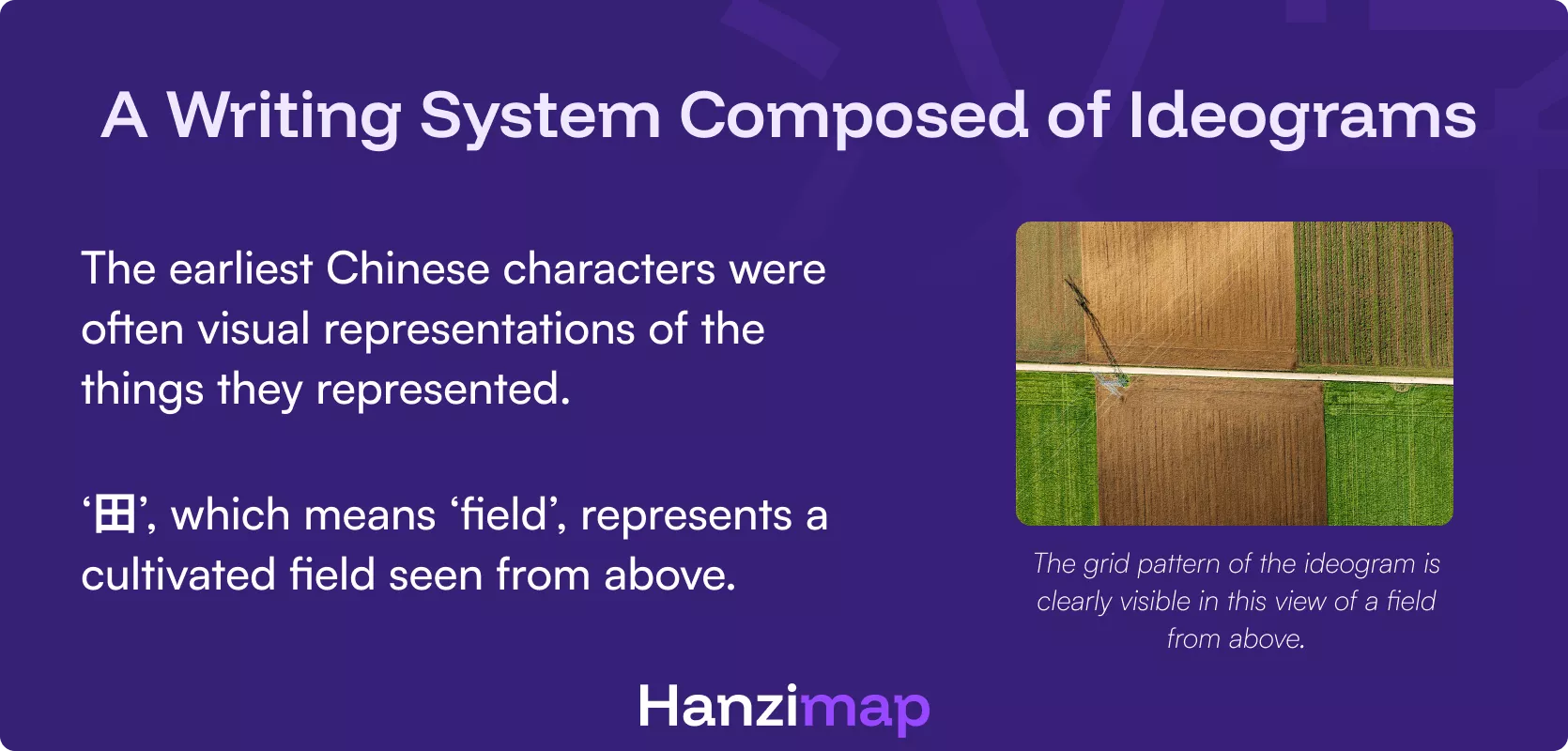
Over time, these simple forms evolved into more elaborate sinograms, which combine several ideograms to obtain a new meaning. We then speak of pictograms, compound ideograms or even ideophonograms.
Let's take the example of the character 明 (míng), which means “clear” or “luminous”: it is formed by two elements: 日 for “sun” and 月 for “moon”, which combined, translate the idea of clarity.
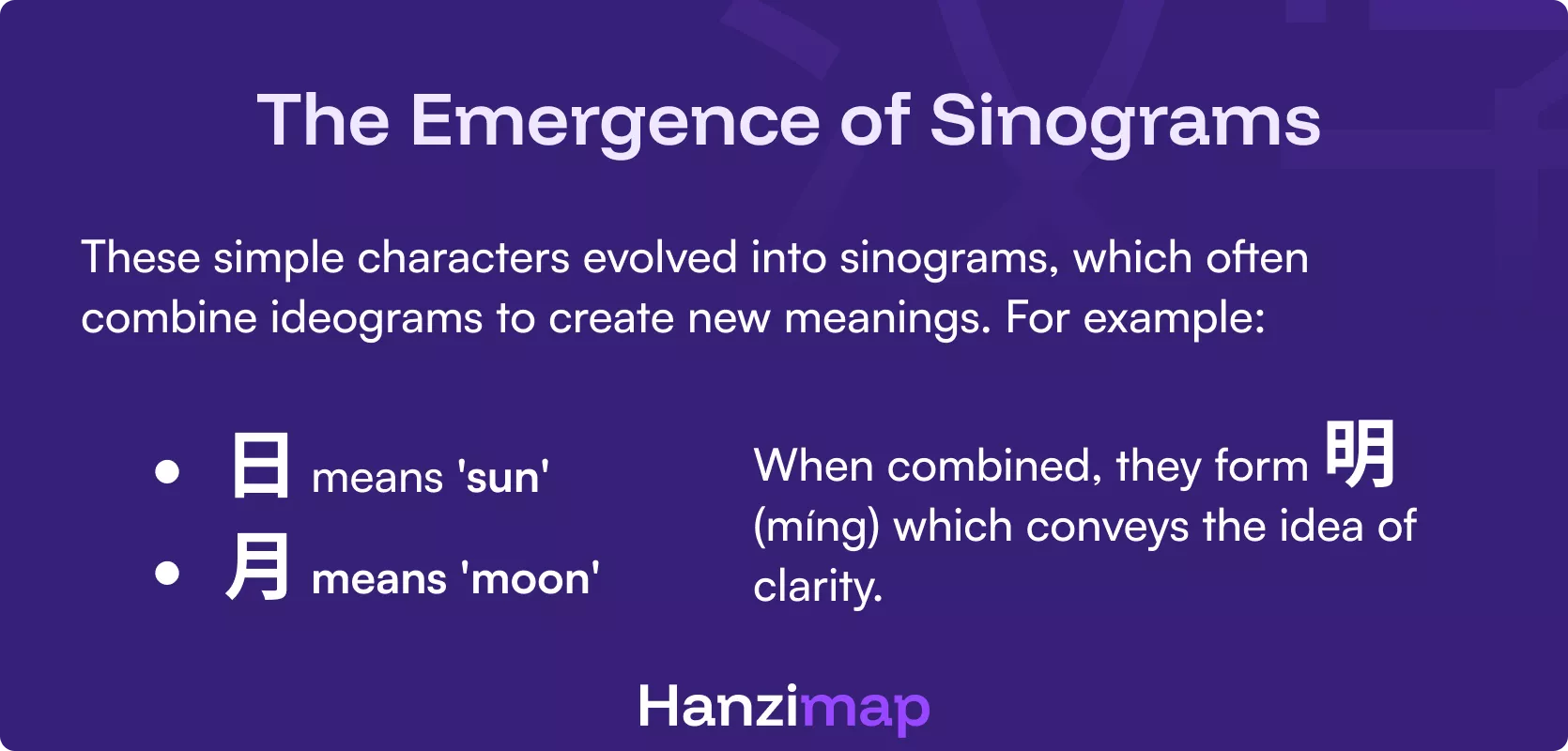
This gradual transition from ideogram to sinogram gave birth to a rich, subtle and visually expressive writing, capable of transmitting nuances that an alphabet does not always allow to express so directly.
How many Chinese characters are there?
There are so many Chinese characters that the various sources available cannot agree on a specific number. While the majority believes that there are around 50,000 hanzi today, the Zhonghua Zihai dictionary references 85,568 characters, and the Taiwan Ministry of Education recognises 106,230. In any case, our 26-letter alphabet pales in comparison to these thousands of characters...
These sinograms each have their own pronunciation and meaning, and their colossal number has already chilled more than one learner. However, Don't worry: in practice, knowing the 3,000 to 5,000 most used characters will be enough for you to understand the majority of current conversations.
Chinese character types: simplified and traditional
Today, there are two main types of Chinese characters:
- Traditional Chinese characters, used since ancient times.
- Simplified Chinese characters, created in the 1950s to promote literacy in mainland China.
This simplification has come to reduce the number of traits of many characters. For example:
- 愛 (love) became 爱
- 馬 (horse) became 马
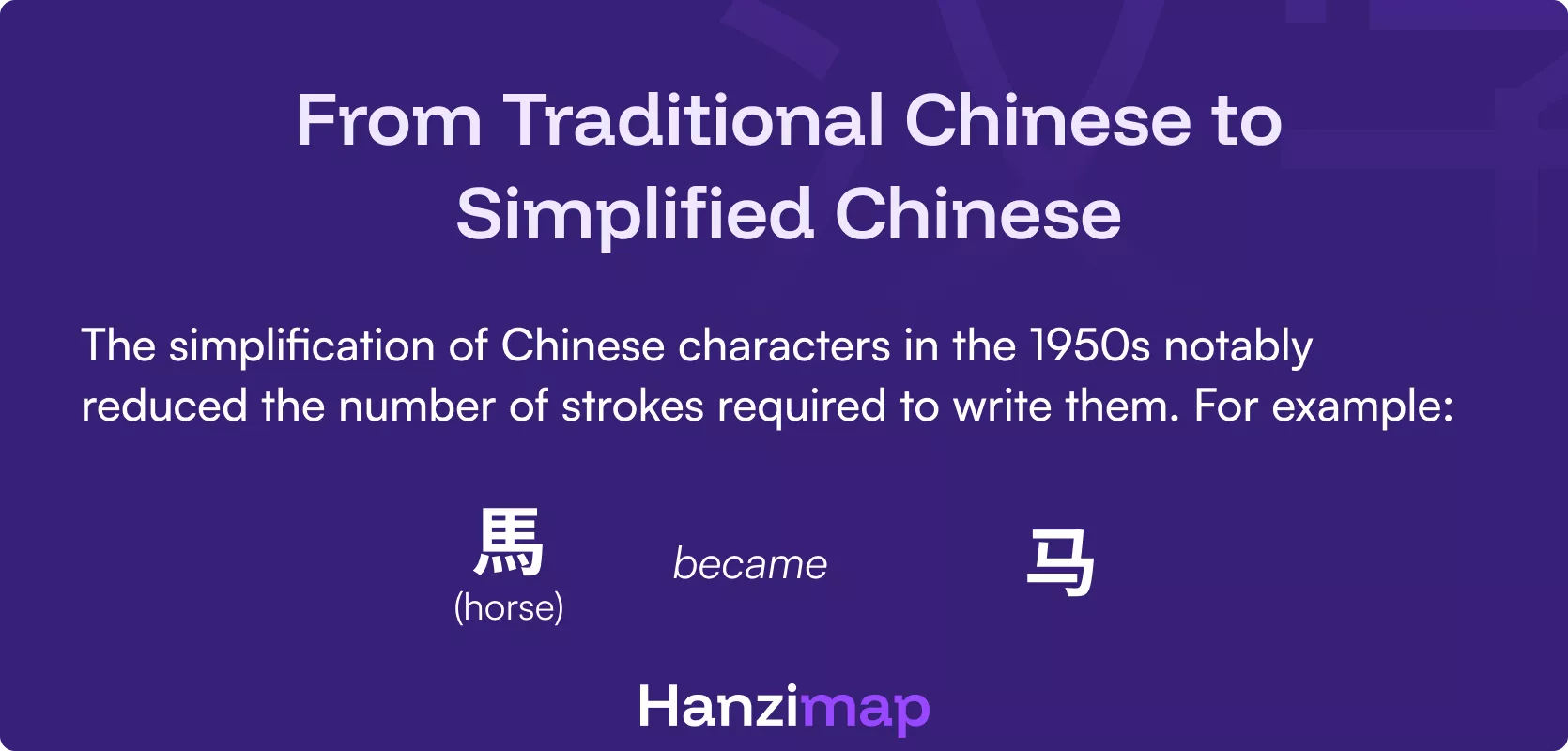
It is the learning of simplified characters that is offered in priority, whether you are learning Chinese online or even in China. On the other hand, traditional Chinese is still the norm in some territories, especially in Taiwan, where it is used in official documents, education, and even for everyday uses (press, literature, etc.).
Discovery of Pinyin, the Chinese phonetic alphabet
Even though Chinese does not have an alphabet, there is a very practical system for Transcribe Mandarin sounds with Latin alphabet letters : the Pinyin, a romanization tool that can be compared to a Chinese phonetic alphabet.
Established in the 1950s, this romanization system aims to facilitate the learning of the Chinese language for foreigners as well as for native speakers. It is also the most used system today for typing in Chinese on a computer or telephone keyboard.
To put it simply, Pinyin combines initials (consonants) and finals (vowels) to form syllables. In addition, there are the four tones of Mandarin, which influence pronunciation and are indicated using accents (for example, mā, má, m, and mà). These tones are important because they can completely change the meaning of a word! For example, depending on its tone, the syllable “ma” may mean “mom”, “horse”, “hemp”, or “insult/scold.”
But while pinyin can be very useful, There is only one phonetic tool left. Rather than replacing the learning of Chinese characters, this romanization system therefore complements it.
Cultural note: There is actually not one, but two Chinese phonetic alphabets, the second being Zhuyin (also called the Bopomofo system). While Pinyin is mostly used in mainland China, Zhuyin is the preferred transcription system in Taiwan. Unlike Pinyin, Zhuyin uses symbols that represent sounds and not the letters of the Latin alphabet. But rest assured, mastering a single phonetic alphabet will be enough for you to learn Mandarin!
How do we transcribe our alphabet from A to Z in Chinese?
Even though there is no Chinese alphabet, It is possible to write letters from A to Z with Hànzì (you will find their pronunciation in brackets):
- A: 阿 (ā)
- B: 贝 (bèi)
- C: 色 (sè)
- D: 德 (dé)
- E: 饿 (è)
- F: 艾弗 (ài fú)
- G: 日 (rì)
- H: 阿什 (ā shí)
- I: 伊 (yī)
- J: 鸡 (jī)
- K: 卡 (kǎ)
- L: 艾勒 (ài lè)
- M: 艾马 (ài mǎ)
- N: 艾娜 (ài nà)
- O: 哦 (ó)
- P: 佩 (pèi)
- Q: 苦 (kǔ)
- R: 艾和 (ài hé)
- S: 艾丝 (ài sī)
- T: 特 (tè)
- U: 玉 (yù)
- V: 维 (wéi)
- W: 独布勒维 (dú bù lè wéi)
- X: 伊克斯 (yī kè sī)
- Y: 伊格黑克 (yī gé hēi kè)
- Z: 贼德 (zéi dé)
But in fact, This transcription is mainly equivalent to a phonetic correspondence that will be of little use to you.. Indeed, Latin letters are not used as they are in Chinese writing, and in the end they will only be used in very specific cases, if you need to:
- Spell a foreign name in an administrative context, or an address to send a letter or package outside of China.
- Read an international abbreviation (like “USB” or “TV”),
- Read foreign brand names or concepts phonetically integrated into modern Chinese (such as “路易威登” for “Louis Vuitton”).
In these specific cases, the sinograms used therefore do not translate the meaning of the letters, and only imitate their pronunciation.
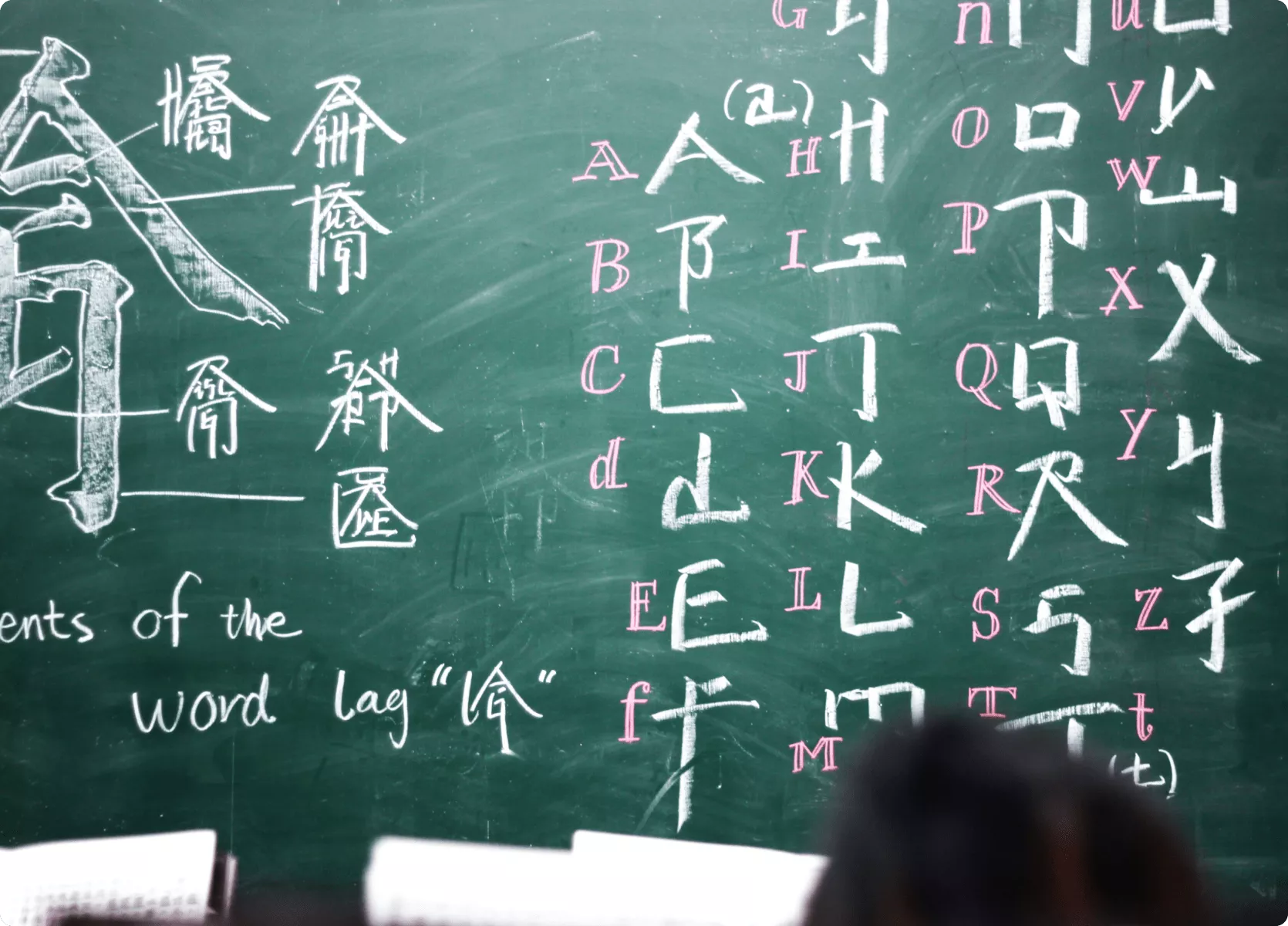
Our 7 tips for learning to write in Chinese
Faced with the large number of characters to remember, many people who want to learn Chinese are discouraged. However, there are tips to remember the sinograms and make more effective progress:
1. Start with radicals
Chinese sinograms are often composed of” radicals ”, basic elements that come up frequently.
Radicals (部首 bùshǒu) are fundamental elements that make up the majority of sinograms, and knowing them will help you:
- Understand the overall meaning of a character. Many radicals have semantic value. For example, the radical 氵(simplified form of 水, “water”) is often present in characters related to water, like 河 (hé, which means river) or 洗 (xǐ, which means to wash). By remembering it, you will know that if it appears in a character you don't know, it most likely has something to do with water.
- Facilitate visual memorization. By recognizing a radical, you naturally break down the character into simpler blocks, which helps you anchor the sinogram image in your visual memory.
- Find a character quickly in a dictionary. In dictionaries, characters are often classified according to their stem and number of strokes. Knowing the radicals therefore makes it easier for you to navigate learning resources.
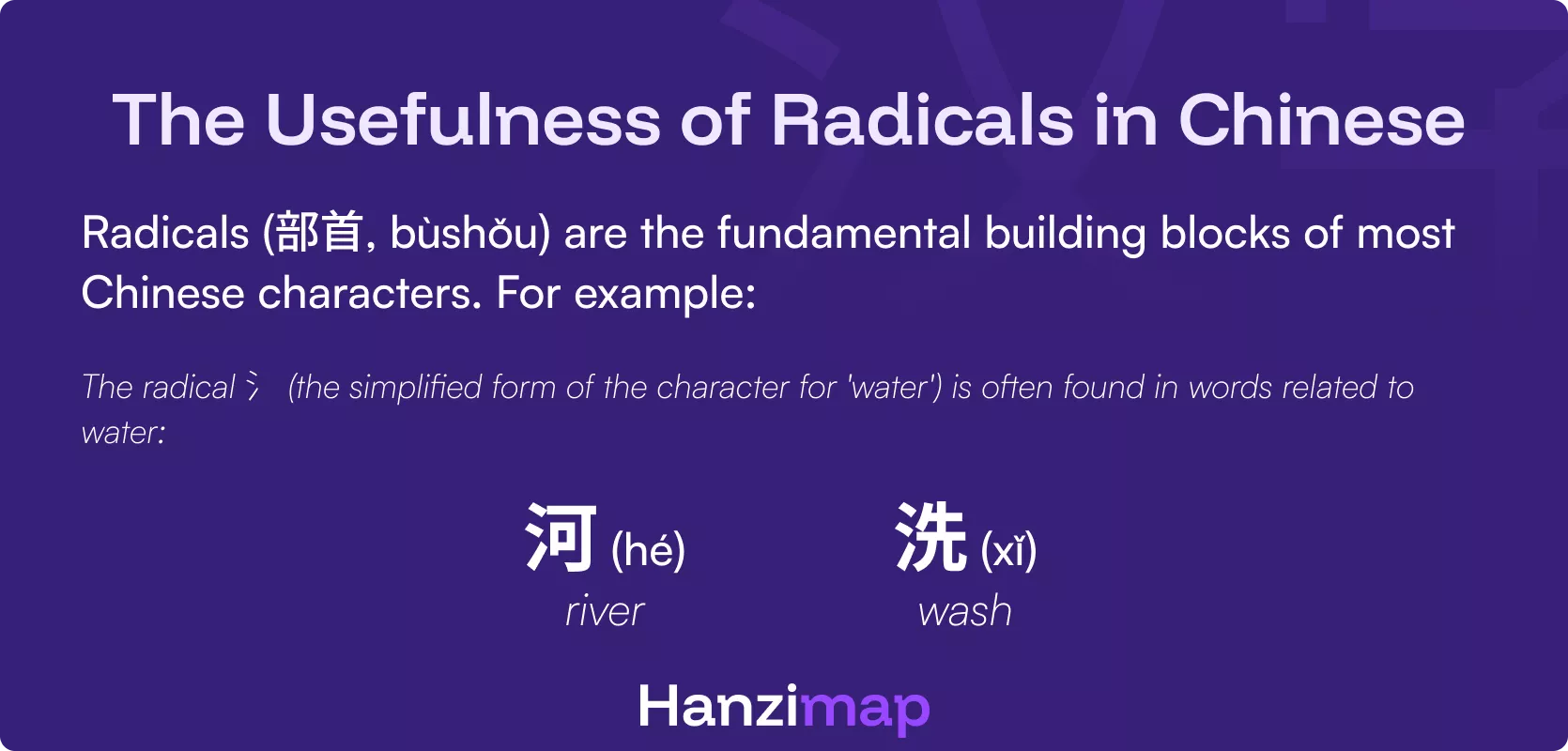
And while there are thousands of different Chinese characters, according to the official Kangxi classification, according to the official Kangxi classification, there are “only” 214 radicals, of which a hundred will be enough for you to cover 80% of the most common sinograms. By focusing on these 100 radicals at the beginning of your apprenticeship, you will therefore progress much faster.
In short, think of radicals as “building blocks” that, once mastered, will make it easier for you to decipher, classify, and remember Chinese characters.
2. Learn the most common characters first
No need to know 10,000 sinograms! The 500 most frequent characters will allow you to understand about 80% of common written Chinese. By targeting these types of characters, you will be able to understand texts much more quickly, which will save you time and help you stay motivated.
3. Practice writing the Hànzì by hand, at least at first
Even though you often write on a smartphone or computer, handwriting will help you remember the visual structure of characters. By writing them, you will better understand the order of their traits, which is essential for writing them properly and recognizing them more easily.
4. Respect the order of the strokes
The order of the traits of Hànzì is not arbitrary. It follows precise rules (from left to right, from top to bottom...) that facilitate learning and guarantee the consistency of writing. Respecting this order is essential if you want to write fast and well in Chinese.
5. Try an app like Hanzimap
Hanzimap is an innovative tool that will help you remember the sinograms and their pronunciation in a fun way.
The principle? In a pinyin grid, you connect an initial, its tone, and its final to get the visual signature of a character. The interest? This signature makes it easier for you to remember the pronunciation of the sinogram, and thus to progress much more quickly, which motivates you to continue.
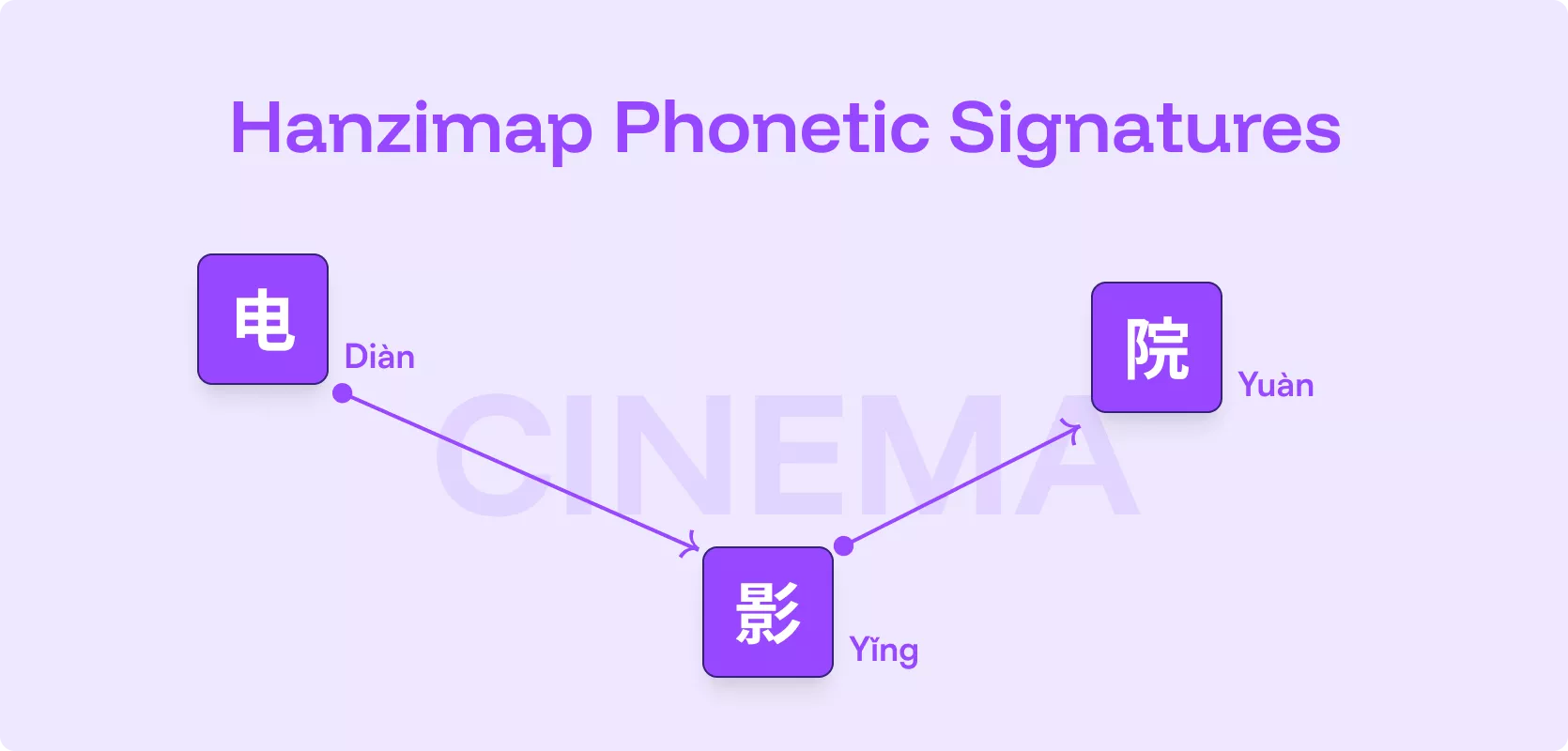
In addition to this grid, you can also enjoy interactive quizzes, which will help you assess your progress and remember characters.
In short, thanks to Hanzimap's gamification, you learn in a fun and sustainable way, which helps you to really make progress in Chinese and to prepare for exams like the HSK. So what are you waiting for to try our platform?
6. Practice regularly, even for a few minutes a day
Discovering a new language is like learning to play a musical instrument: it's better to devote a little time to it every day than to study a few times a month for hours.
Short review sessions are ideal because they create automations: You've gotten into the habit of working a little bit every day, and so your brain is waiting for that moment. In addition, the more you expose your brain to the Chinese language, even briefly, the more receptive it becomes to it and learns to naturally recognize structures, radicals, and sound components.
7. Be patient and kind to yourself
Learning a language is a marathon, not a sprint. This is even more true if you want to learn Chinese, whose writing system is very different from what Westerners are used to.
Especially at the beginning, it is therefore normal for you to forget characters, confuse them or have trouble writing them. The main thing is to go at your own pace, to persevere, to stay curious about the Chinese language and culture. And to help you even more in your learning and boost your motivation, you can also use tools like Hanzimap.
Frequently asked questions about learning the Chinese alphabet
How can I easily remember Chinese characters?
Several tips will help you remember Chinese characters effectively:
- Focus on learning from radicals. A sinogram is often composed of radicals, which give you clues about its meaning and/or pronunciation. Knowing radicals will thus help you to decipher unknown characters, or to find the meaning of those you had forgotten.
- Try a visual method like Hanzimap, whose principle of signatures will help you create a lasting mental trail to remember the pronunciation of characters.
- Alternate between writing by hand, regular exposure to Chinese (via courses, series...) and the use of digital tools. Varying learning materials will boost your memory skills.
Is it possible to learn Chinese by yourself?
As long as you know how to be a bit rigorous, it is entirely possible to learn Chinese by yourself. To help you, you will thus be able to take advantage of the many resources available:
- Online courses, offered for all levels and to be followed at your own pace.
- Chinese romanization systems such as Pinyin, which, thanks to the transcription of sinograms into the Latin alphabet, will help you work on your pronunciation.
- Podcasts, series, movies and videos in Chinese with subtitles in French, that will train your ear and promote your immersion in Chinese culture, even from the other side of the world.
- Tools like Hanzimap, which will help you progress and learn new characters in a fun way through gamification.
What is the best way to master the pronunciation of the Chinese language?
One of the best ways to learn how to pronounce the Chinese language well is to learn Pinyin. This system of romanization of Mandarin is in fact very useful for foreigners who master the Latin alphabet, since it transcribes the pronunciation of sinograms into Latin letters.
Another essential element to improve yourself: immersion. And for that, you won't necessarily even have to go to China! Taking courses with a Chinese speaker, consuming audio content in Mandarin, and even simply increasing contact with Chinese culture are already a very good starting point.
Extra tip: if possible, avoid inferences with other Asian languages, especially Japanese and Cantonese, which seem similar but are very different, and could thus mislead you.
What are the challenges for beginners who want to learn Chinese?
Beginners often encounter difficulties associated with:
- The pronunciation of the characters: The sounds of Mandarin are sometimes very different from those of French. Fortunately, there are romanization and transcription systems like Pinyin to facilitate your learning, but mastering them requires a bit of training, especially to distinguish similar sounds (such as those transcribed by the letters “zh”, “ch”, “ch”, “x” and “q”).
- Memorizing the sinograms: There is no Chinese alphabet, since Chinese writing is based on logographers that each represent an idea. To progress, you must therefore learn several hundred (or even thousands, depending on the level you want to reach) of visual forms, which can seem intimidating without an adapted method.
- The tones: Mandarin uses four tones and one neutral tone, which influence pronunciation. The same syllable can thus have several meanings depending on its intonation. For example, depending on its tonal accent, “ma” can just as easily mean “mom”, “horse”, “hemp” or “insult/scold”. This tonal system is often confusing for beginners.
- Grammar: Chinese grammar is very different from what you are used to in French. No conjugations, strong plurals, or genders, but other elements such as word order, particles, and contextual logic play an essential role, which will require some time to adapt.
Fortunately, there are solutions to overcome some of these challenges. For example, with Hanzimap, you will be able to remember many sinograms in a fun way, while working on your pronunciation and your mastery of tones.
Should you learn Simplified Chinese or Traditional Chinese?
- Simple answer: first focus on simplified Chinese, which was designed to facilitate literacy, and therefore language learning.
- More nuanced answer: it depends on your objective.
If you want to learn Chinese out of linguistic curiosity, simplified Chinese is still the best option. But if your goal is to travel, or even to expatriate yourself in a Chinese-speaking region, you may be forced to learn traditional Chinese. Indeed, while simplified Chinese is popular in mainland China, this is not the case in Taiwan where traditional Chinese prevails.
Finally, in the case of expatriation, also pay attention to the predominant Chinese language: in Hong Kong for example, the official language is Cantonese, not Mandarin!
Other items you might like
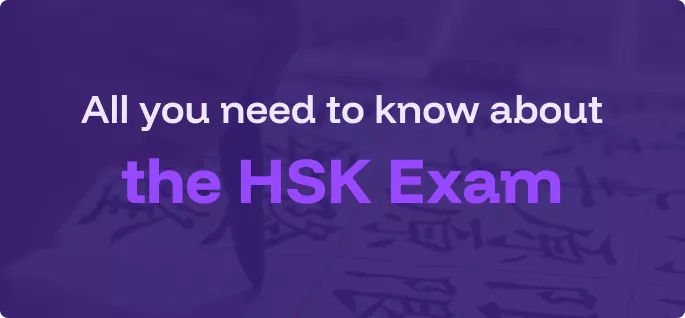
HSK 2025 guide: become an expert on this Chinese language assessment test

How to learn Mandarin Chinese on your own? Our 13 tips for making rapid progress



